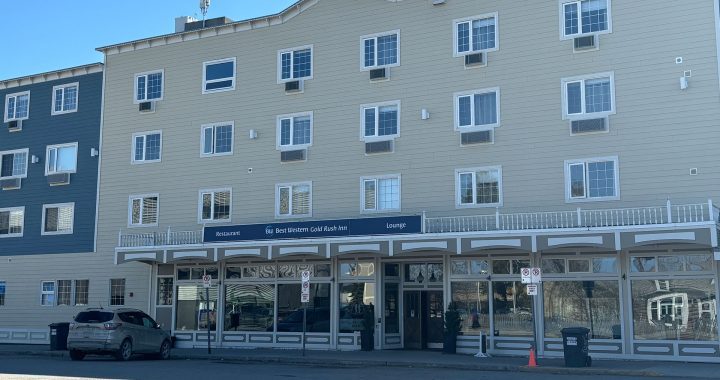(Bruce Shisheesh says the agreement between Attawapiskat and De Beers needs to change. Facebook/Courtesy of Bruce Shisheesh)
By Jorge Barrera
APTN National News
The blockade of a winter road leading to a diamond mine near Attawapiskat ended Thursday evening after an agreement between mining giant De Beers, the chief of this northern Ontario First Nation and protesters.
Bruce Shisheesh, the spokesman for the blockade, said De Beers and Attawapiskat Chief Theresa Spence agreed to reopen the impact benefit agreement (IBA) between the community and the company. Reopening the IBA was a core demand of the protesters, which blocked the winter road leading to the Victor diamond mine on Monday.
“We did the first step, now I have to follow it up to make sure it’s followed through,” said Shisheesh, who is also an evangelical evangelist. “We talked about reopening the IBA and discussing some stuff that we are missing in the IBA.”
De Beers, however, made no mention of reopening the agreement in a statement issued late Thursday evening.
“The resolution to the blockade just outside Attawapiskat First Nation was mainly focused in two areas: employment and training and maximizing the benefits available in the (IBA),” said the statement.
Shisheesh said the blockade, which began Monday evening, ended at about 6:30 p.m. after James Kirby, the Victor mine’s manager, and Spence signed an agreement committing to working together to improve the IBA between De Beers and Attawapiskat. The original IBA was signed in 2005.
Shisheesh said he asked Spence to go to the blockade. Spence could not be reached for comment.
De Beers said in a statement the company has already been in discussions with Attawapiskat on the IBA through a “renewed relationship work group” formed last July to “maximize the benefits for both sides.” De Beers said the issues that surface during the week would now be included as part of the discussions.
Shisheesh said the IBA needs to address issues such as health and housing.
“The IBA doesn’t really benefit our community and that is the reason why I took the step to be involved in the blockade,” he said.
Shisheesh said between 10 and 12 men and women formed the core group behind the blockade and they braved temperatures that dropped below -40 C. Shisheesh said he spent the first night inside an idling pick-up truck.
“Of course we had coffee and some snacks in there. Four of us were sitting in a truck and the transport trucks had turned away. We didn’t want them to sneak in again,” he said.
De Beers said the blockade had forced it to cease operations on the road. The company depends on the winter road, which connects the mine to Moosonee, Ont., to ship fuel, machine parts and equipment to heavy to be flown in.
The mine flies the diamonds out via charter.
Shisheesh said the mine was on the verge of running out of fuel when the blockade ended.
De Beers spokesman Tom Ormsby, however, denied that was the case.
“Our current supply is more than sufficient to take us beyond the end of the winter road,” said Ormsby.
The mine sits about 90 kilometres west of Attawapiskat, one of the poorest First Nations communities in Canada.
Shisheesh said his family also has concern about De Beers exploring across their traditional trapline territory.
“Somebody gave them permission from inside the community so they could explore there and they claim they didn’t,” said Shisheesh. “De Beers Canada said they put money in for compensation to the band and that the chief and council would pay it and we never got it.”
Shisheesh said it was “tempting” to continue the blockade until it forced the mine to shut down.
“A lot of people would rather see the mine shut down, but at the same time I thought about the people that work there from my reserve,” he said. “It wasn’t for only the IBA we were blocking the road, we wanted our young people from Attawapiskat to work there.”
Shisheesh lives in Thunder Bay, Ont., but is originally from Attawapiskat where most of his family still resides. He said he is now considering staying in his home community.
“We will see what my heavenly father has for me,” he said.
@JorgeBarrera
[email protected]










See? That’s the way its done! If you want something from a company, to break a contract or get more money, or WHATEVER you want, just conduct yourself like a spoiled child, threaten, block the company from doing business, stomp and cry, and then get what you want! Awesome! What’s to stop this reserve or ANYONE ELSE from conducting themselves this way? Nice example, you represent your people well. What’s your next stunt? http://www.facebook.com/GiveNoMore
Its unfortunate that they had blocked the local community members from working too, who is gonna pay them for the loss of wages, I am gonna urge them to go after the blockaders to be re-imburse their wage loss…why not? The blockade had stated that it was only suppose to be for Debeers and transport convoys but that’s not what happened, they blockaded everyone including the community members who were working on the winter road…They talk about employment but never considered those that are working on the road trying to feed their families, isn’t that employment?…